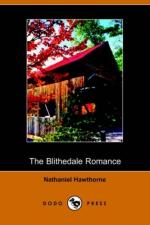Skirting farther round the pasture, I heard voices and much laughter proceeding from the interior of the wood. Voices, male and feminine; laughter, not only of fresh young throats, but the bass of grown people, as if solemn organ-pipes should pour out airs of merriment. Not a voice spoke, but I knew it better than my own; not a laugh, but its cadences were familiar. The wood, in this portion of it, seemed as full of jollity as if Comus and his crew were holding their revels in one of its usually lonesome glades. Stealing onward as far as I durst, without hazard of discovery, I saw a concourse of strange figures beneath the overshadowing branches. They appeared, and vanished, and came again, confusedly with the streaks of sunlight glimmering down upon them.
Among them was an Indian chief, with blanket, feathers, and war-paint, and uplifted tomahawk; and near him, looking fit to be his woodland bride, the goddess Diana, with the crescent on her head, and attended by our big lazy dog, in lack of any fleeter hound. Drawing an arrow from her quiver, she let it fly at a venture, and hit the very tree behind which I happened to be lurking. Another group consisted of a Bavarian broom-girl, a negro of the Jim Crow order, one or two foresters of the Middle Ages, a Kentucky woodsman in his trimmed hunting-shirt and deerskin leggings, and a Shaker elder, quaint, demure, broad-brimmed, and square-skirted. Shepherds of Arcadia, and allegoric figures from the “Faerie Queen,” were oddly mixed up with these. Arm in arm, or otherwise huddled together in strange discrepancy, stood grim Puritans, gay Cavaliers, and Revolutionary officers with three-cornered cocked hats, and queues longer than their swords. A bright-complexioned, dark-haired, vivacious little gypsy, with a red shawl over her head, went from one group to another, telling fortunes by palmistry; and Moll Pitcher, the renowned old witch of Lynn, broomstick in hand, showed herself prominently in the midst, as if announcing all these apparitions to be the offspring of her necromantic art. But Silas Foster, who leaned against a tree near by, in his customary blue frock and smoking a short pipe, did more to disenchant the scene, with his look of shrewd, acrid, Yankee observation, than twenty witches and necromancers could have done in the way of rendering it weird and fantastic.
A little farther off, some old-fashioned skinkers and drawers, all with portentously red noses, were spreading a banquet on the leaf-strewn earth; while a horned and long-tailed gentleman (in whom I recognized the fiendish musician erst seen by Tam O’Shanter) tuned his fiddle, and summoned the whole motley rout to a dance, before partaking of the festal cheer. So they joined hands in a circle, whirling round so swiftly, so madly, and so merrily, in time and tune with the Satanic music, that their separate incongruities were blended all together, and they became a kind of entanglement that went nigh to turn one’s brain with merely looking at it. Anon they stopt all of a sudden, and staring at one another’s figures, set up a roar of laughter; whereat a shower of the September leaves (which, all day long, had been hesitating whether to fall or no) were shaken off by the movement of the air, and came eddying down upon the revellers.




